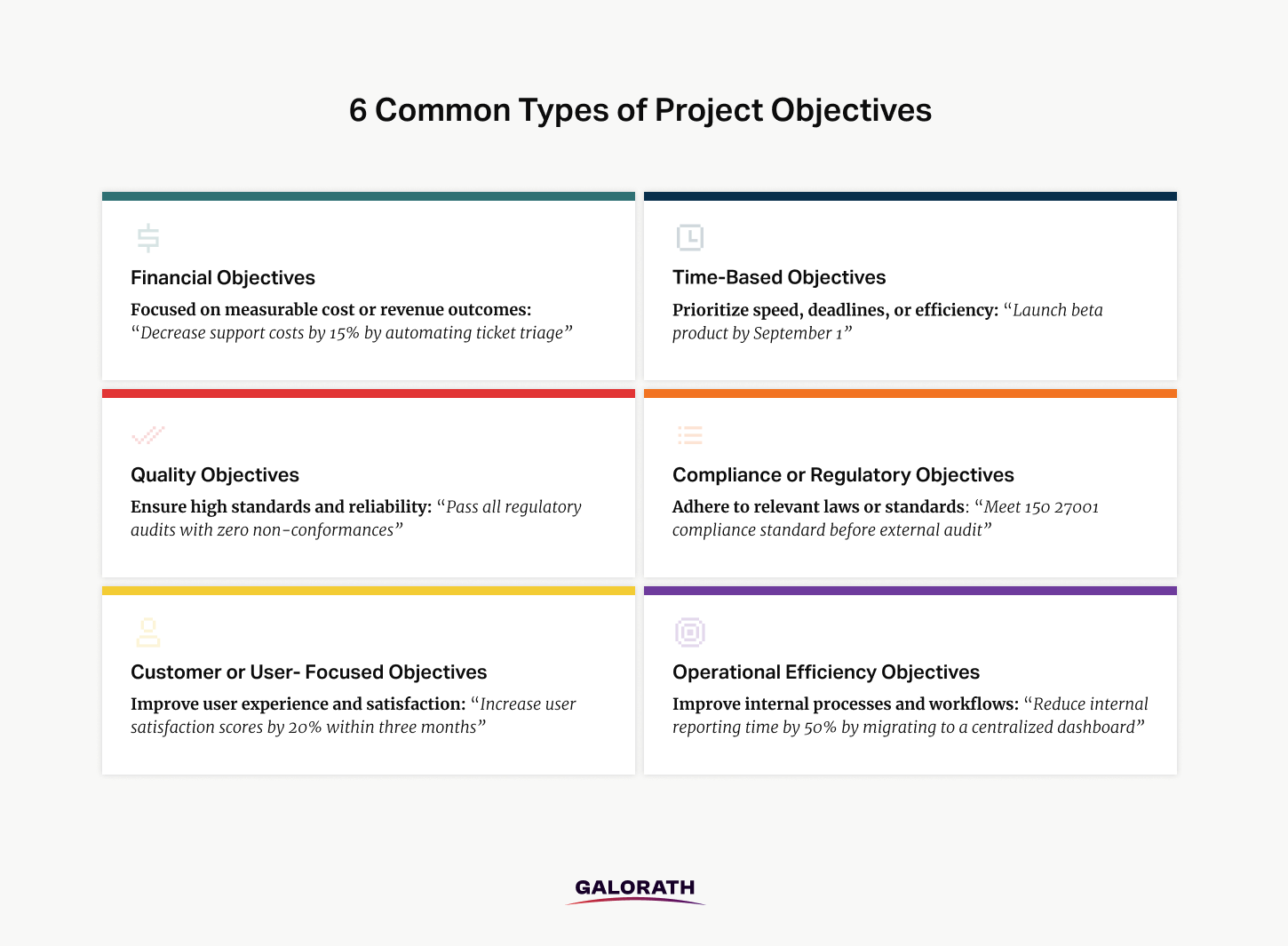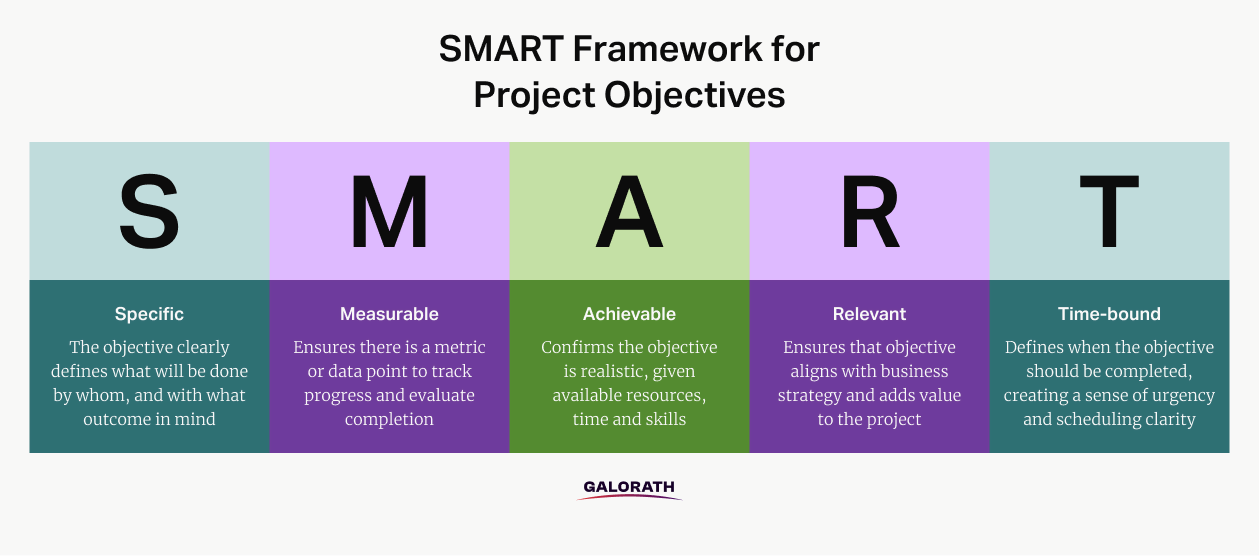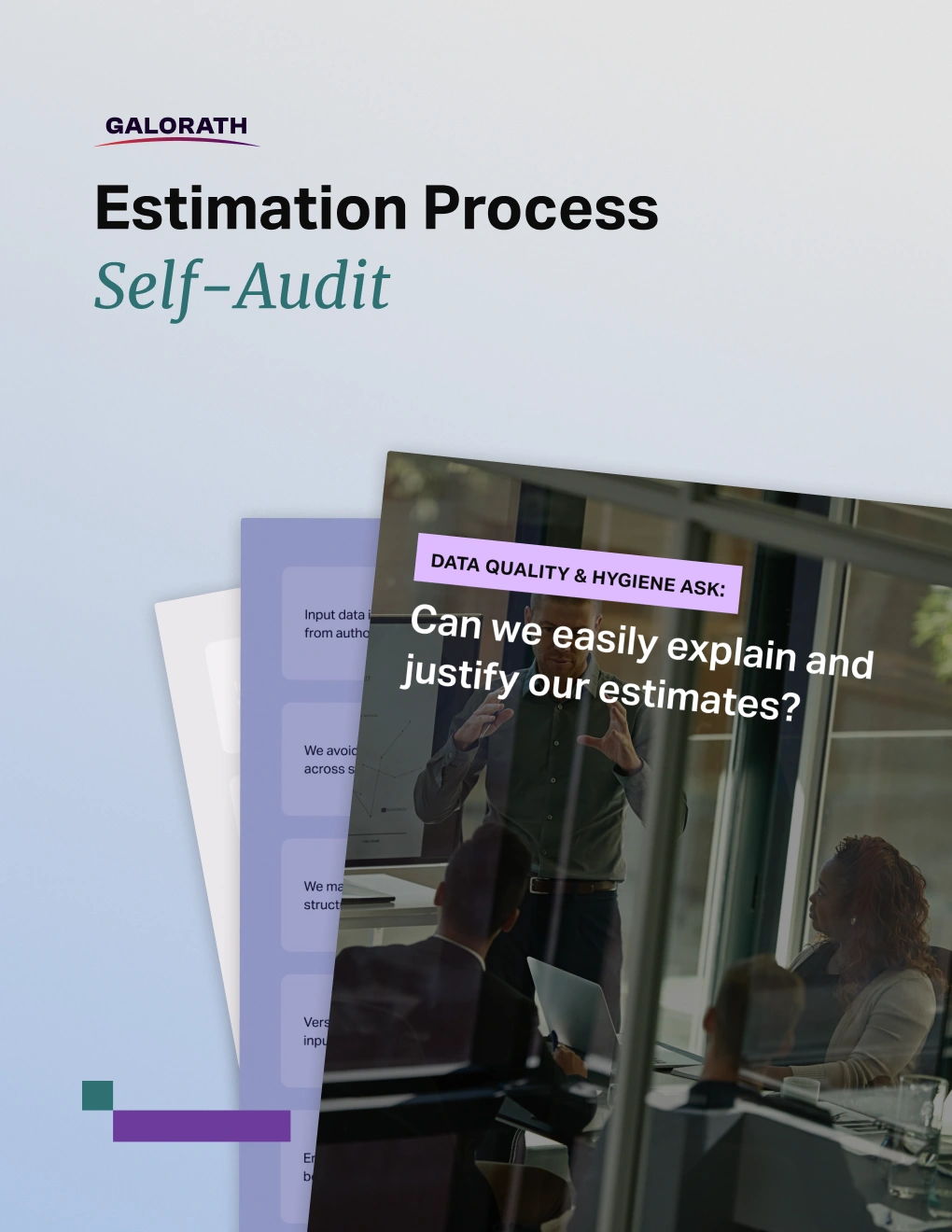Mastering Cost Risk with the CRED Model: A New Approach to Managing Uncertainty
Project objectives drive project success by defining clear, measurable outcomes that guide planning, execution, and evaluation. Unlike broad strategic goals, project objectives are specific, time-bound targets that provide a shared understanding of success across all stakeholders. By anchoring tasks and deliverables to defined results, objectives help teams prioritize efforts, allocate resources, and stay aligned throughout the project lifecycle.
Project objectives support business strategy by translating high-level organizational goals into tactical actions and performance benchmarks. These objectives provide a roadmap for achieving outcomes like improved efficiency, cost reduction, compliance, or customer satisfaction. Well-defined objectives bridge the gap between abstract goals and practical implementation, ensuring that projects deliver measurable value.
Project objectives must be specific, measurable, achievable, relevant, and time-bound (SMART) to be effective. A SMART framework helps teams avoid vague statements like “improve service” and instead define outcomes like “reduce customer complaint resolution time by 50 percent by the end of Q2.” These structured objectives increase clarity, support accurate estimation, and guide project scope development.
Project objectives differ from project scope, plans, milestones, and deliverables because they describe what success looks like rather than how it is achieved. Objectives provide direction and impact, while scope outlines work boundaries, plans define the execution path, milestones mark progress, and deliverables represent tangible outputs. All of these elements work together, but only objectives define the reason behind the work.
Project objectives must be tracked using measurable KPIs, milestones, dashboards, and review checkpoints. Consistent tracking ensures accountability, informs decision-making, and supports performance evaluation throughout the project lifecycle.
Large-scale initiatives require more rigorous objective-setting that includes alignment with estimation methods, early validation with AI, risk scenario modeling, and cost-performance metrics. By tying objectives to parametric models and real-time tracking tools, organizations can gain visibility into progress, adjust plans proactively, and ensure every dollar spent delivers strategic value.
What Are Project Objectives?
Project objectives are specific, measurable outcomes that a project is designed to achieve within a defined time frame and budget. These objectives guide the planning, execution, and evaluation of a project by providing a clear definition of success for all stakeholders involved.
Project objectives describe the “what” of a project – what it will deliver, what results it will generate, and what criteria must be met for the project to be considered complete. Unlike broad goals or vision statements, project objectives are narrow in focus and aligned to specific deliverables, milestones, and key performance indicators (KPIs).
According to the Project Management Institute (PMI), “Project objectives must be clearly defined to ensure a shared understanding of project expectations among stakeholders.” Clear objectives act as a communication tool, performance benchmark, and decision-making filter throughout the project lifecycle.
Project objectives are important because they help align team members, sponsors, and clients around a shared definition of success. They establish accountability by creating targets against which performance can be measured. Objectives set the direction for the project, helping teams focus their work and evaluate progress toward meaningful results.
Here are a few examples of well-written project objectives:
- “Launch a mobile-friendly version of the customer portal by Q4 to increase self-service usage by 30%.”
- “Implement a new cost estimation model that reduces quote turnaround time from 5 days to 2 days within the next 90 days.”
- “Train 100 team members on the new CRM platform by the end of the fiscal year.”
These examples show how clear objectives improve project focus, stakeholder communication, and performance measurement. They provide the necessary foundation for building a scope statement, setting a budget, creating a schedule, and allocating resources effectively.
The following visual explains what project objectives are and illustrates how they serve as the link between high-level strategic goals and practical, on-the-ground implementation.

When Should Project Objectives Be Written?
Project objectives should be written during the project initiation or early planning phase to establish a clear direction before any work begins. Setting objectives early ensures alignment between stakeholders, project managers, and teams, allowing everyone to agree on what success looks like before time and resources are committed.
Project objectives are written at the beginning of the project so they can guide the development of scope, budget, timeline, and resource plans. Objectives provide the foundation for all other project documentation, including the Work Breakdown Structure (WBS), risk assessment, and cost estimation models.
It also creates a baseline for evaluating progress during execution and verifying success during closeout. If objectives are vague, late, or evolving without control, the project is more likely to suffer from miscommunication, scope creep, and missed deadlines.
Key Factors to Keep in Mind When Defining Project Objectives
You define better project objectives by carefully considering the business value, scope, timeline, available resources, and stakeholder expectations. Each objective should reflect a realistic and strategic outcome that directly contributes to the overall goals of the organization.
One critical factor to consider is alignment with business strategy. Objectives should support high-level organizational priorities such as cost reduction, market expansion, compliance, or digital transformation. When objectives are linked to broader outcomes, they gain more stakeholder support and funding visibility.
Another important factor is measurability. Vague goals like “improve service delivery” should be replaced with precise metrics such as “reduce response time from 24 hours to 6 hours.” Objectives help project managers focus their teams and resources in the right direction—and track progress along the way.
Here are additional elements to consider when defining project objectives:
- Timeframe – Objectives should include clear deadlines to create urgency and facilitate milestone tracking.
- Feasibility – Consider constraints such as budget, staffing, and technology. Overambitious objectives often lead to project failure.
- Stakeholder input – Gathering input from decision-makers and end users ensures objectives reflect real needs.
- Dependencies and risks – Understand what must be true for the objective to be achieved, and plan around possible obstacles.
This visual outlines four key considerations for defining clear and actionable project objectives.

Taking the time to evaluate these factors results in objectives that are realistic, actionable, and aligned with project success.
How Detailed Should Project Objectives Be?
Project objectives should be detailed enough to guide execution while remaining focused enough to avoid micromanaging the work. Each objective must provide a clear understanding of what needs to be achieved, who will be responsible, how it will be measured, and when it should be completed.
You add the right level of detail by making sure each objective answers the following questions:
- What is being delivered?
- Why is it important?
- Who is responsible?
- What are the success criteria?
- When must it be completed?
Too little detail leaves room for interpretation, leading to conflicting efforts and unclear responsibilities. Too much detail, on the other hand, can restrict flexibility and overwhelm teams with unnecessary complexity. The goal is to strike a balance that supports autonomy while maintaining accountability.
Here are examples of poorly and well-defined objectives for comparison:
- Poor: “Improve customer experience”
- Better: “Increase customer satisfaction scores by 15% within 6 months by launching a user feedback system and resolving complaints within 48 hours.”
Well-written objectives provide the clarity needed to build detailed plans and track performance without constant guesswork.
Why Is Defining Project Objectives Important?
Defining project objectives is important because it establishes a clear roadmap for what the project is intended to accomplish and how success will be measured. Objectives bring structure to an otherwise abstract vision, aligning project teams, sponsors, and stakeholders around shared expectations.
Project objectives are essential for setting direction and making decisions throughout the project lifecycle. Without clearly defined objectives, teams lack focus, risk drifting from their purpose, and struggle to justify time and resource investments. According to The Digital Project Manager, “Strong project objectives provide clarity, reduce ambiguity, and create measurable benchmarks.”
Defining objectives early ensures that project scope, tasks, and deliverables remain tied to specific business outcomes. When project teams are aligned on the “why,” they are better positioned to resolve conflicts, manage scope creep, and navigate trade-offs. Well-defined objectives also help identify what’s out of scope—making it easier to say no to work that doesn’t contribute to success.
Project objectives also support accountability and performance evaluation. By linking tasks and milestones back to specific objectives, project managers can track progress, report outcomes to stakeholders, and assess whether the project achieved its intended impact. This is especially important in industries like aerospace, defense, and manufacturing, where goals must be clearly tied to compliance, technical specs, or customer requirements.
How Project Objectives Connect to Broader Business Strategy?
Project objectives support strategic execution by translating high-level business goals into concrete, actionable outcomes. While strategy sets the direction for the organization, project objectives define how that strategy will be realized through specific initiatives.
You connect project objectives to business strategy by ensuring each objective aligns with a measurable impact, such as cost reduction, customer growth, operational efficiency, or technology advancement. According to Plan.io, “Your project objectives should stem directly from your organizational strategy—otherwise, your project may deliver results that don’t matter.”
Project objectives are typically documented in the project charter or project scope statement and then referenced throughout planning and execution. They influence prioritization, resource allocation, and team alignment by acting as a filter for decision-making. When everyone understands how their work contributes to a broader strategic goal, motivation and accountability increase.
Here’s how project objectives serve as a bridge between high-level vision and day-to-day activity:
Strategic goal: Expand into new markets
Project objective: Launch a localized version of the software in three new countries by Q4
Strategic goal: Improve profitability
Project objective: Implement an AI-driven estimation tool to reduce project bidding costs by 20% within 12 months
Strategic goal: Strengthen customer loyalty
Project objective: Redesign support portal to reduce average resolution time to under 6 hours
The following visual presents these three practical examples of how strategic goals can be effectively translated into specific, measurable project objectives.

By tying project-level actions to enterprise-level goals, organizations can ensure that every project contributes meaningfully to the bigger picture.
Project Objectives vs. Project Goals
Project goals define the broader vision, the high-level, strategic outcomes a project aims to achieve, while objectives break that vision into specific, measurable steps. Goals provide direction, while objectives create a clear roadmap for execution.
A goal answers the “why” behind a project, such as “Expand into new markets” or “Improve user satisfaction.” It sets the purpose but lacks specific success criteria or deadlines. Objectives, on the other hand, define the “what,” “how,” and “when,” making goals actionable. For example, if the goal is to improve user satisfaction, an objective could be “Redesign the onboarding experience to reduce support tickets by 30% in Q3.” Separating goals from objectives ensures better tracking, accountability, and alignment with long-term strategy.
Project Objectives vs. Project Scope
Project scope is different from project objectives because scope defines the boundaries of the work, while objectives define the outcomes the work is meant to achieve. Scope sets the parameters for what is included and excluded in the project, whereas objectives focus on the desired results.
You use project scope to describe the work to be done, the resources required, and the constraints or limitations the team must operate within. This includes specific deliverables, timelines, stakeholders, and detailed task breakdowns. Project scope is often documented in the project scope statement and visualized through tools like the Work Breakdown Structure (WBS).
While the scope might include “develop a reporting dashboard,” the objective tied to that scope could be “improve internal decision-making by reducing reporting time by 50%.” Project scope provides the execution framework, while project objectives provide the strategic compass.
Project Objectives vs. Project Milestones
Project milestones represent checkpoints or progress markers, while objectives define the desired outcomes the project is working toward. Milestones help track progress on the path to achieving objectives but are not the end goal themselves.
You use project milestones to measure how far along a project is at a specific point in time. Milestones do not represent completed deliverables or performance targets but rather signal that a key phase, task group, or event has been completed.
Project objectives focus on results, while milestones focus on events. A project objective might be to “reduce processing time by 30 percent within the next quarter,” while a milestone would be “system performance testing completed.” The objective reflects what the project is trying to achieve. The milestone reflects a key moment along the way.
Milestones help with visibility, communication, and accountability by marking when specific tasks or phases should be completed. They are commonly used in Gantt charts, project dashboards, and progress reports to create structure and drive momentum. A project can hit all its milestones and still fail if it does not meet its objectives.
Project Objectives vs. Business Objectives
Business objectives differ from project objectives because business objectives define high-level organizational goals, while project objectives define the specific outcomes a single project must achieve to support those broader goals. Business objectives set the direction for the company, and project objectives are tactical steps that help achieve that direction.
Business objectives are long-term, strategic targets established by leadership to drive growth, profitability, market share, or innovation. These objectives often appear in annual business plans, quarterly performance reviews, or investor communications. For example, a business objective might be to “Increase market share by 10 percent in the North American region by the end of next year” or “Achieve $2 million in recurring revenue from new products in 18 months.”
Project Objectives vs. Project Plan
A project plan outlines how the work will be executed, while project objectives define what the project aims to achieve. The plan is a tactical roadmap, while objectives provide strategic direction.
A strong project plan details tasks, timelines, resource allocation, risk management, and communication workflows, ensuring teams stay on track. It evolves as the project progresses, adapting to new challenges. Objectives, on the other hand, remain stable and guide the plan’s structure.
For example, an objective might be to “reduce manual reporting time by 40%,” while the plan breaks it down into steps like conducting user research, developing integrations, and scheduling training. Managing both in parallel ensures clear direction and effective execution.
Project Objectives vs. Project Deliverables
Project deliverables are the tangible outputs of a project, while objectives define the measurable outcomes those deliverables aim to achieve. Deliverables are the “what,” and objectives are the “why.”
Deliverables include documents, software, prototypes, or reports – things that can be produced, tested, and approved. For example, if the goal is to improve financial reporting, a deliverable might be “a functional reporting dashboard with data export.”
Objectives, on the other hand, focus on impact. While deliverables are checked off, objectives measure success. A project can complete all deliverables but still fail if the intended results—like increasing user satisfaction—aren’t met.
6 Types of Project Objectives
There are several types of project objectives because different projects aim to produce different types of outcomes. Objectives vary based on what the organization values, what the project is trying to achieve, and how performance will be measured. While every project should be grounded in measurable results, those results can relate to cost, time, quality, compliance, stakeholder satisfaction, or other critical success factors.
Here are 6 common types of project objectives:
1. Financial Objectives
Financial objectives are focused on measurable cost or revenue outcomes that the project is expected to impact. These objectives help justify the investment and are often used to evaluate project return on investment (ROI).
A financial objective might aim to reduce operational expenses, increase profitability, avoid compliance penalties, or capture new revenue streams. For example, a cost-focused objective could be “Decrease support costs by 15 percent by automating ticket triage,” while a revenue-focused goal might be “Generate $1.2 million in new customer subscriptions within six months of launch.”
Financial objectives are typically reviewed by project sponsors, executives, or financial controllers, and are critical to making go or no-go decisions.
2. Time-Based Objectives
Time-based objectives prioritize speed, deadlines, or efficiency improvements. These objectives are often tied to go-to-market strategies, regulatory timelines, seasonal demand, or resource availability.
Examples of time-based objectives include “Launch beta product by September 1” or “Reduce delivery lead time from 12 weeks to 6 weeks.” These objectives push the team to structure the schedule effectively and often require trade-offs between time, cost, and scope.
Time-based objectives are especially important in competitive industries where being first to market offers a strategic advantage.
3. Quality Objectives
Quality objectives focus on the standard, reliability, or performance of the project outputs. These objectives help ensure that deliverables meet both internal and external expectations for functionality, usability, and compliance.
A typical quality objective might be “Achieve 99.9 percent uptime for system performance post-deployment” or “Pass all regulatory audits with zero non-conformances.” Quality objectives often require thorough testing, validation, and documentation, especially in industries like aerospace, defense, and healthcare.
Quality-focused planning improves customer satisfaction, reduces risk, and supports long-term sustainability of the delivered solution.
4. Compliance or Regulatory Objectives
Compliance objectives ensure that the project adheres to required laws, policies, or standards. These may include data privacy regulations, industry certifications, environmental laws, or internal governance protocols.
For example, a project may have an objective to “Meet ISO 27001 compliance standards before external audit” or “Ensure accessibility standards (WCAG 2.1) are implemented in all public-facing tools.” These objectives are often non-negotiable and must be prioritized regardless of cost or schedule constraints.
Regulatory objectives can shape both scope and risk strategy, especially in government, finance, and highly regulated industries.
5. Customer or User-Focused Objectives
Customer-focused objectives aim to improve user experience, increase satisfaction, or drive adoption. These objectives are tied directly to how end users interact with the project outcomes.
Examples include “Increase user satisfaction scores by 20 percent within three months” or “Achieve 85 percent onboarding completion within the first 14 days.” These objectives often involve usability research, iterative design, and user feedback loops.
Meeting these goals requires empathy, data, and continuous improvement, especially in product development and service delivery projects.
6. Operational Efficiency Objectives
Operational objectives target improvements in internal processes, tools, or workflows. These projects often support back-end transformation, automation, or system integration.
A project with an operational focus might have an objective like “Reduce internal reporting time by 50 percent by migrating to a centralized dashboard” or “Eliminate 10 manual steps in the procurement process.” These objectives deliver value by freeing up resources, increasing accuracy, or speeding up internal execution.
Operational efficiency is often invisible to external users but provides long-term cost savings and scalability for the organization.
This image highlights the 6 most common types of project objectives.

Benefits of Clearly Defined Project Objectives
Clearly defined project objectives provide a strong foundation for successful planning, execution, and measurement of project outcomes. When objectives are specific, measurable, and aligned with stakeholder needs, they improve team alignment, reduce uncertainty, and increase the chances of delivering real value. The following sections explore the most important benefits of setting clear project objectives.
Improve Project Focus and Alignment
Clear project objectives improve focus and alignment by giving every team member a shared understanding of what the project is trying to achieve. When objectives are vague or undefined, team members may interpret priorities differently or work toward unrelated goals, creating confusion and inefficiencies.
Objectives act as a communication tool between stakeholders, leadership, and the project team. They allow everyone to align around a common purpose, eliminating guesswork and helping prioritize tasks that have the greatest impact. Well-defined objectives align teams and clarify what success looks like, which is especially important in cross-functional environments where responsibilities may overlap.
Support Better Estimation and Planning
Clear project objectives support better estimation and planning by establishing a reliable basis for scoping, scheduling, and budgeting. Without defined objectives, it becomes difficult to model cost, duration, or risk with confidence.
When objectives include measurable outcomes, such as “launch product to 10,000 users by Q2” or “reduce turnaround time by 30 percent,” estimators can build more accurate forecasts based on known performance targets. Objectives also guide scope definition and task decomposition, which in turn feeds the Work Breakdown Structure (WBS), resource plans, and risk assessments.
Projects that begin with clear objectives are less likely to experience budget overruns or missed deadlines because planning is grounded in tangible results rather than assumptions or generalized goals.
Reduce Scope Creep and Rework
Clear project objectives reduce scope creep and rework by establishing boundaries for what the project is meant to accomplish. When the end goal is well defined, it becomes easier to evaluate whether a new feature, change request, or additional requirement aligns with the project’s intent.
Without clear objectives, teams may struggle to say no to work that adds complexity but not value. This often leads to projects drifting off-course, overextending budgets, and delaying delivery.
When teams use objectives as a filter for decision-making, they are more likely to maintain focus, minimize rework, and protect timelines.
Enable Meaningful Measurement and Success Tracking
Clear project objectives enable meaningful measurement and success tracking by providing a standard against which progress can be evaluated. Without objectives, it is difficult to tell whether a project is on track, underperforming, or delivering real value.
Defined objectives help teams establish performance indicators, track milestones, and conduct post-project evaluations. Objectives like “increase customer retention by 15 percent” or “achieve 98 percent defect-free manufacturing output” make it easy to verify whether the project delivered on its promise. Asana emphasizes that setting objectives upfront gives teams a “framework for evaluating whether the project succeeded or needs improvement.”
When success is measured against clear objectives, teams can confidently communicate results to stakeholders, justify budget and resource allocations, and capture lessons learned for future initiatives.
Guidelines for Defining Effective Project Objectives
Writing effective project objectives requires more than listing what a project should accomplish. It involves aligning expectations, ensuring clarity, and building a foundation for measurable outcomes. Clear objectives improve communication, reduce ambiguity, and help teams track performance against strategic goals.
You define better project objectives when you consider scope, stakeholder input, timelines, and organizational priorities. Without alignment in these areas, even well-written objectives can lead to confusion or conflict. Dependencies like cross-functional input, business strategy, and available resources must be understood before objectives are locked in.
When establishing project objectives, consider these key tips:
- Start with strategy: Make sure every objective aligns with larger business or program-level goals. If an objective cannot be tied back to value, it may not be necessary.
- Include the right voices: Collaborate with stakeholders, end users, and technical leads. This ensures objectives are realistic and reflect the needs of all involved parties.
- Be specific but flexible: While clarity is essential, objectives should leave room for iterative refinement and input from the team during planning.
- Validate dependencies: Check that your timeline, resources, or tools can support what the objective is asking. Ambitious objectives often require systems, integrations, or data sources that may not be ready.
Once the groundwork is in place, project teams can use the SMART framework to create actionable objectives that are easier to manage and evaluate.
SMART Framework for Project Objectives
The SMART framework helps teams write project objectives that are actionable, measurable, and grounded in reality. SMART stands for Specific, Measurable, Achievable, Relevant, and Time-bound.
You use the SMART framework to convert broad project intentions into structured, performance-focused objectives. Instead of writing vague goals like “Improve customer service,” SMART encourages clarity with statements like “Increase customer satisfaction ratings from 80 percent to 90 percent by the end of Q2.”
Each element of these SMART goals for project managers plays a distinct role:
- Specific means the objective clearly defines what will be done, by whom, and with what outcome in mind.
- Measurable ensures there is a metric or data point to track progress and evaluate completion.
- Achievable confirms the objective is realistic given available resources, time, and skills.
- Relevant ensures the objective aligns with business strategy and adds value to the project.
- Time-bound defines when the objective should be completed, creating a sense of urgency and scheduling clarity.
The visual below illustrates the SMART framework—Specific, Measurable, Achievable, Relevant, and Time-bound—used to define clear and effective project objectives that support successful delivery.

Using SMART criteria reduces misunderstandings and builds accountability into the project from day one. This framework is one of the most widely used methods for improving project outcomes.
How to Write SMART Objectives
You write SMART objectives by working through each component of the SMART acronym and refining your statement until it meets all five criteria. This process turns a general idea into a goal that can be measured, managed, and communicated.
Start by identifying what success looks like. Ask, “What specifically are we trying to change or improve?” This becomes the specific part of the objective. Then ask, “How will we measure that success?” Your answer will define the measurable portion, using metrics such as time savings, cost reductions, quality improvements, or user behavior.
Once measurable, you move to achievability. This requires evaluating your team’s capacity, available tools, timeline, and budget. Ambitious goals should be broken down into smaller, achievable objectives that reduce risk and increase team motivation.
Next, ensure your objective is relevant by confirming it supports project scope and business strategy. Objectives that do not align with organizational priorities can distract resources or create unnecessary work.
Finally, make it time-bound by setting a realistic deadline. Deadlines help drive progress and serve as checkpoints for evaluating success. For example:
Poor objective: “Improve reporting process”
SMART objective: “Reduce monthly reporting time by 25 percent by transitioning to automated dashboards by the end of Q3”
SMART objectives help eliminate ambiguity and provide clear direction throughout the entire project lifecycle.
Project Objectives Examples
Project objective examples help teams understand the difference between vague intentions and clearly defined, actionable goals. Reviewing both good and bad examples illustrates what effective objectives look like and why specificity, measurement, and alignment are so important.
Good project objectives provide structure, guide decision-making, and offer a way to evaluate success. Poorly written objectives, on the other hand, create confusion, lack accountability, and often lead to scope creep or missed expectations. When objectives are unclear, teams waste time working on the wrong priorities or interpreting success differently.
Use the table below to compare bad and good project objectives across various industries and project types:
| Use Case / Industry | Bad Project Objective | Good Project Objective |
| Software Development | Improve the user interface | Redesign the user dashboard by Q2 to reduce support tickets by 30 percent |
| Marketing | Increase brand awareness | Launch a digital campaign by May that reaches 250,000 impressions with a 3 percent CTR |
| Manufacturing | Make production more efficient | Reduce production cycle time from 8 days to 5 days per unit by implementing lean practices |
| IT / Infrastructure | Upgrade our servers | Replace legacy servers with cloud infrastructure by July to improve system uptime to 99.9% |
| Construction | Build the new office on time | Complete Phase 1 structural framing by October 15 and pass safety inspections by October 30 |
| Customer Support | Handle tickets faster | Reduce average ticket resolution time from 48 to 24 hours by implementing new triage system |
| Education / Training | Improve employee onboarding | Deliver a new onboarding course and achieve a 90 percent completion rate within 30 days |
| Healthcare | Enhance patient experience | Implement a self-check-in kiosk at all clinics by Q4 to reduce wait times by 15 percent |
| Finance / Reporting | Improve reporting process | Automate monthly financial reports to reduce manual work by 50 percent within 3 months |
| Government / Compliance | Ensure regulatory compliance | Complete ISO 27001 audit readiness checklist and documentation by end of fiscal year |
Each bad example fails because it is vague, lacks a time frame, or does not provide a measurable target. The good examples fix these issues by being specific, measurable, achievable, relevant, and time-bound.
How to Track Project Goals and Objectives
Tracking project goals and objectives requires a structured process that includes measurable targets, regular progress reviews, and the right tools to monitor success.
You track project goals and objectives most effectively by aligning them with key performance indicators (KPIs), setting clear timelines, and reviewing progress against milestones. Objectives should be broken into actionable steps and tied to project deliverables, budgets, and timelines.
Each objective must be paired with specific success metrics that can be tracked regularly to assess whether the project is on target.
A common method for tracking objectives is using goal tracking frameworks, such as:
- KPIs (Key Performance Indicators): These are numerical metrics that reflect how well an objective is being met. For example, if an objective is to improve system uptime, the KPI might be a 99.9% availability target.
- OKRs (Objectives and Key Results): This model links high-level objectives with 2–5 measurable outcomes that reflect progress. This approach is often used in agile environments and works well for product and performance-driven teams.
- Milestone Checkpoints: For each objective, assign milestones that indicate partial progress. Milestones can be used to trigger reviews, audits, or course corrections.
- Scorecards or Dashboards: These provide visual summaries of objective performance and can be reviewed in status meetings or sent to stakeholders for transparency.
Project tracking software plays a critical role in monitoring goals and objectives because it allows for centralized updates, real-time reporting, and team-wide visibility. Using tools that connect task management with objectives helps reduce administrative overhead and improves accountability.
Here are some software platforms that help teams track project objectives:
- ClickUp: ClickUp allows teams to create goals at the workspace, project, or task level and link them to specific metrics. It supports real-time progress bars, goal folders, and OKR-style reporting. This helps teams keep high-level goals visible across different workflows.
- Asana: Asana’s goal-tracking features allow users to define objectives, assign owners, track updates, and visualize progress through dashboards. Goals can be set at the company, team, or individual project level.
- Project Manager: This platform integrates project planning with time tracking, Gantt charts, and real-time dashboards. Users can link objectives to tasks and update performance metrics to reflect progress.
- Jira (with Confluence): Commonly used in software development, Jira supports tracking through epics, user stories, and issue management. When paired with Confluence, teams can document goals, link progress, and provide a full audit trail.
To ensure tracking is effective, teams should also implement regular check-ins. These may take the form of weekly standups, monthly reviews, or phase-end evaluations. During these sessions, teams should review actual performance against objectives, note variances, and take action to realign if needed.
Tracking objectives should not be a one-time activity. It is an ongoing process that involves communication, accountability, and the ability to adjust based on new data. When tracked properly, objectives become a roadmap for project success, providing insight into whether the team is moving in the right direction or needs to change course.
Best Practices for Setting Project Objectives in Large-Scale Projects
Setting project objectives in large-scale initiatives requires a higher degree of precision, validation, and alignment than in smaller projects. When stakes are high, the risk of ambiguity, misalignment, or underestimation grows quickly. Clear objectives in these environments must account for cost, schedule, risk, and performance expectations from day one.
Project objectives in large programs are not just task-level descriptions; they drive funding, shape contracts, and guide estimation models. To ensure they provide real value, organizations must take a disciplined approach to defining, validating, and managing these objectives across teams and systems. The following best practices are essential for getting it right.
Aligning Objectives with Cost Estimation Methodologies
You set better project objectives in large-scale projects by aligning them directly with cost estimation methodologies. Without this alignment, objectives can become disconnected from the realities of effort, resourcing, or complexity.
Effective objectives serve as inputs to estimation software solutions like SEER by Galorath, enabling teams to tie cost models directly to measurable outcomes. SEER is an AI-powered, industry leading, estimation platform, which enables large organizations to set project objectives that are both ambitious and realistically achievable—grounded in decades of proven modeling expertise and enterprise client history.
As a platform built specifically for large-scale, high-stakes programs, SEER transforms abstract goals into quantifiable, data-driven targets by linking objectives directly to cost, schedule, effort, and risk models. For example, instead of writing “Develop new subsystem,” an aligned objective might be “Deliver avionics subsystem with 95 percent fault coverage for $12 million by Q3.” This kind of detail supports parametric modeling and sensitivity analysis.
Planners can input performance-based objectives—such as delivery timelines, fault coverage targets, or compliance levels—and receive structured feedback from SEER on the feasibility, resourcing needs, and cost implications of each objective. This allows teams to pressure-test their assumptions early, validate scope against available resources, and develop a planning framework built on evidence, not guesswork.
When objectives are written with estimation in mind, they help generate reliable forecasts, justify funding requests, and allow decision-makers to test scenarios based on scope and performance changes. Teams should involve cost engineers early in the objective-setting process to validate assumptions and structure data inputs.
Using AI and Automation to Validate Objectives Early
You improve the accuracy of project objectives by using AI and automation to validate feasibility and identify inconsistencies during the planning phase. Large projects generate complex interdependencies that are often missed without automated support.
AI-enabled estimation tools, such as SEER, can analyze historical data, industry benchmarks, and project variables to recommend achievable objectives. For example, if a team sets an objective to reduce development time by 40 percent, an AI model trained on similar past projects can flag whether this is historically achievable based on system size, complexity, and available resources.
Automated logic checks and integration with estimation software can also validate alignment between scope, schedule, and cost targets. This early feedback loop allows teams to refine objectives before they are used in stakeholder communication or contract proposals.
Incorporating Risk Assessment into Objective Setting
You create more resilient project objectives by incorporating risk assessment as part of the definition process. In large-scale projects, risk exposure can significantly alter cost and delivery targets if not accounted for up front.
Each objective should be assessed against known risks, including technical challenges, vendor dependencies, regulatory requirements, or data limitations. If an objective assumes third-party integration, for example, but the integration partner has not been secured, this introduces delivery risk that should be captured and quantified.
Defining Clear Cost Performance Metrics Linked to Objectives
You enhance project control and accountability by defining cost performance metrics that are directly tied to each objective. In large programs, this linkage helps teams track whether financial investments are producing expected value.
Each project objective should include a way to measure cost efficiency, such as “cost per feature,” “unit cost versus baseline,” or “cost variance at completion.” These metrics allow stakeholders to assess not just whether the objective was completed, but whether it was completed within the economic boundaries set during planning.
Cost performance metrics also help identify early signs of misalignment between effort and output. If a project is consuming 80 percent of its budget but only delivering 40 percent of its objectives, this signals a problem that may require re-scoping or re-prioritization.
Project estimation platform SEER helps with tracking and visualizing these relationships, helping leadership stay informed about progress, cost effectiveness, and whether objectives are delivering the expected return.
Common Mistakes and Challenges in Defining Project Objectives
Defining project objectives may seem straightforward, but large-scale projects often suffer from vague, unrealistic, or misaligned objectives that undermine performance from the start. These missteps create ripple effects that show up as cost overruns, delays, scope creep, and missed targets.
Another frequent challenge is the absence of clearly assigned ownership for each objective. When no one is responsible for an outcome, it often slips through the cracks or gets reinterpreted by different stakeholders. Projects experience delays when objectives are revisited mid-execution due to miscommunication or lack of accountability.
Finally, many teams define objectives without reconciling them with actual budget and resource constraints. Setting a goal to launch a product in six months without confirming team capacity or vendor availability leads to unrealistic expectations. Large organizations need a feedback loop between planning, estimation, and objective setting to ensure alignment from day one.
The Role of Objectives in Cost Estimation and Risk Analysis
Project objectives influence cost estimation and risk analysis by defining what the project is expected to deliver and under what conditions. Clear objectives shape the scope of work, which in turn determines the tasks, resources, and timelines needed to meet that objective.
You improve cost estimation accuracy by linking objectives to scope statements and then mapping those statements to a cost breakdown structure (CBS) or work breakdown structure (WBS). Each objective should inform the deliverables and milestones that drive cost models. When an objective includes targets like “achieve 90 percent reliability within 12 months,” estimators can build effort models, resource allocations, and schedule estimates that reflect this performance requirement.
Objectives also define the assumptions built into the cost model. If the objective implies specific quality standards, testing levels, or integration requirements, those need to be included in both time and cost calculations. If they are not defined early, the result is often underestimated budgets or inaccurate bid proposals.
In risk analysis, objectives provide the basis for evaluating what is at stake if something goes wrong. A well-defined objective allows teams to quantify the cost of failure or delay. This becomes especially important when building probabilistic models of risk and uncertainty, which require clarity on deliverables, value, and constraints.
Estimation platforms like SEER rely on detailed, objective-aligned inputs to model a range of cost and schedule outcomes. When objectives are poorly defined or constantly changing, the cost model loses integrity and can no longer serve as a reliable decision-support tool.
This graphic demonstrates how clearly defined project objectives influence the accuracy of cost estimation and the effectiveness of risk analysis, reinforcing their critical role in project planning and decision-making.

Aligning Project Objectives with Risk Management and Uncertainty Modeling
Project objectives play a central role in risk management because they define the conditions that must be met for a project to succeed. Poorly defined objectives introduce hidden risks that are often missed during early planning, only to surface during execution when they are more expensive to resolve.
You reduce project risk by ensuring that each objective is feasible, clearly scoped, and aligned with available data and resources. When objectives are unclear or unrealistic, they increase uncertainty in effort estimates, introduce ambiguity in deliverables, and reduce the effectiveness of mitigation planning.
Uncertainty modeling depends on knowing what needs to be achieved, how confident the team is in their ability to achieve it, and what factors could disrupt it. If an objective is to “achieve full compliance with international cybersecurity standards,” and the team lacks clarity on the standard’s requirements or available budget, this creates uncertainty that must be quantified and addressed.
Poor alignment between objectives and risk planning often leads to false confidence in project readiness. Without linking each objective to potential risks—such as technical failure, supplier issues, or resource shortages—project managers cannot build accurate contingency reserves or scenario plans.
SEER platform incorporates uncertainty modeling by requiring users to define confidence levels, constraints, and known unknowns tied to each objective. When those objectives are vague or missing context, risk models produce distorted outputs, making it harder to anticipate overruns or plan effective mitigations.








